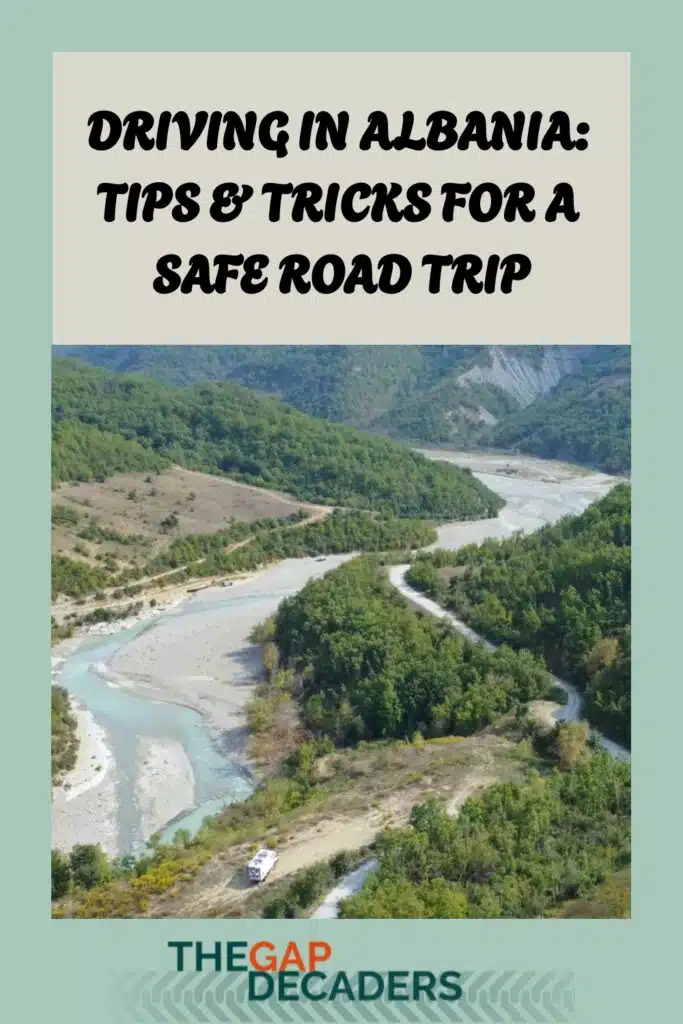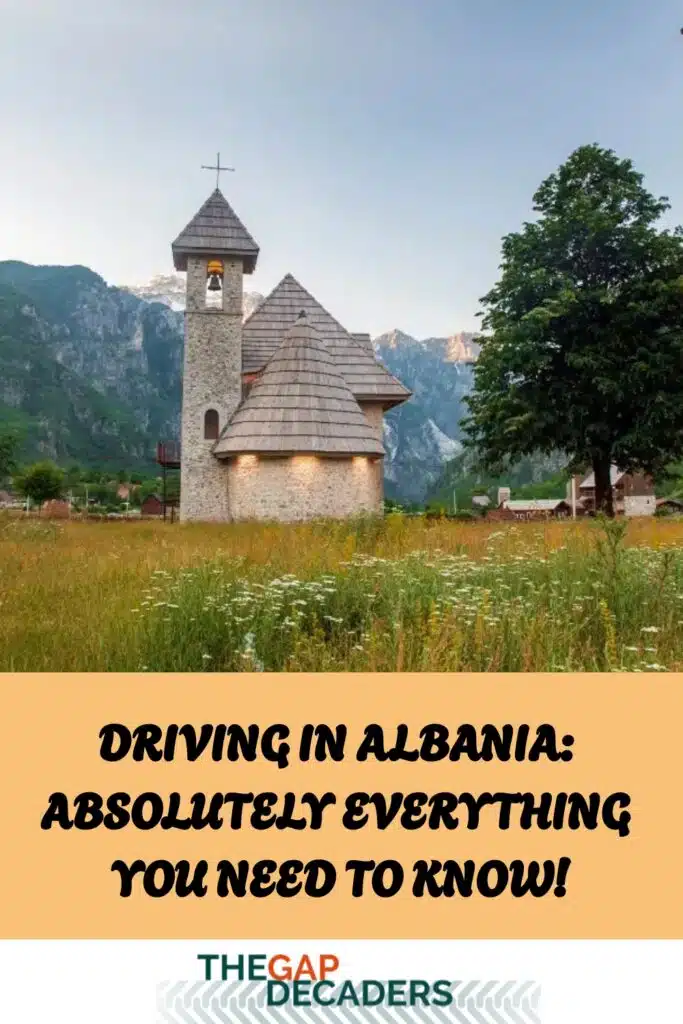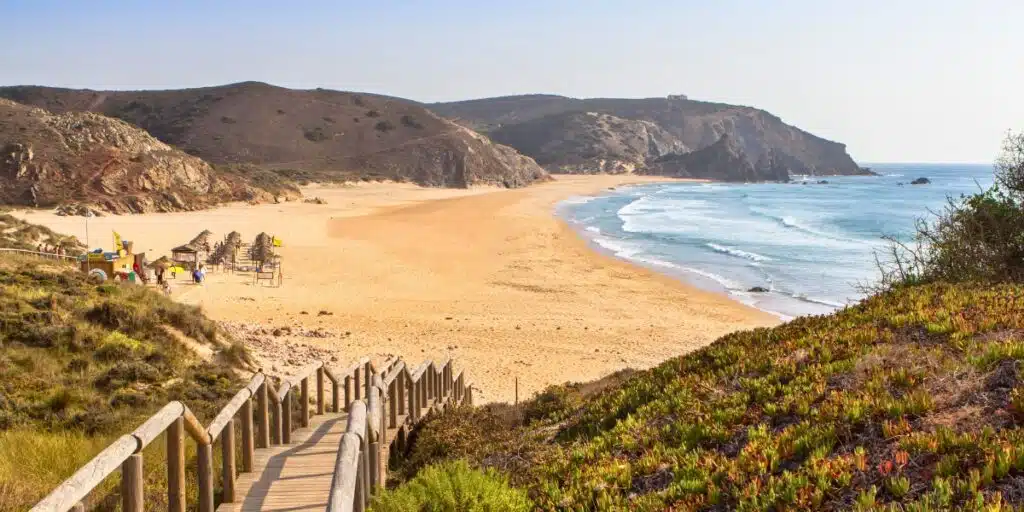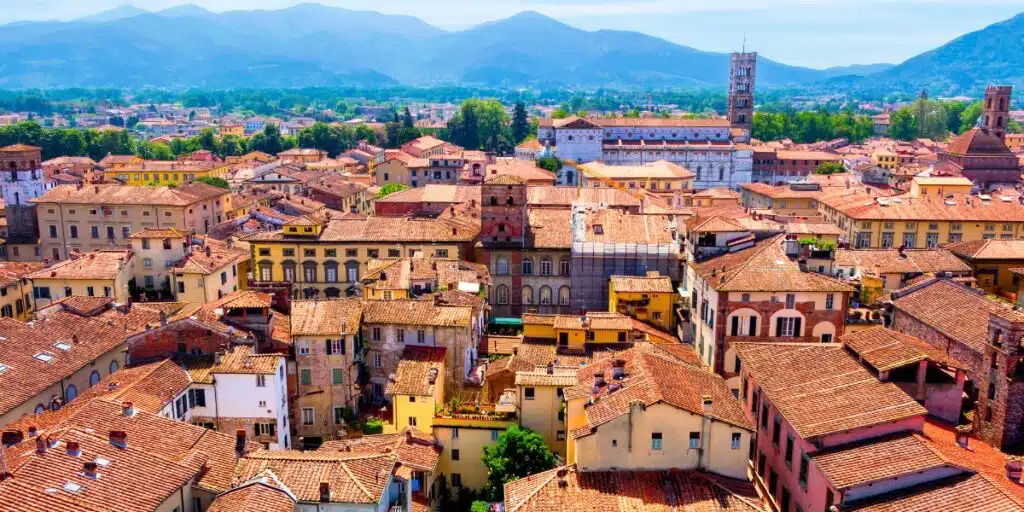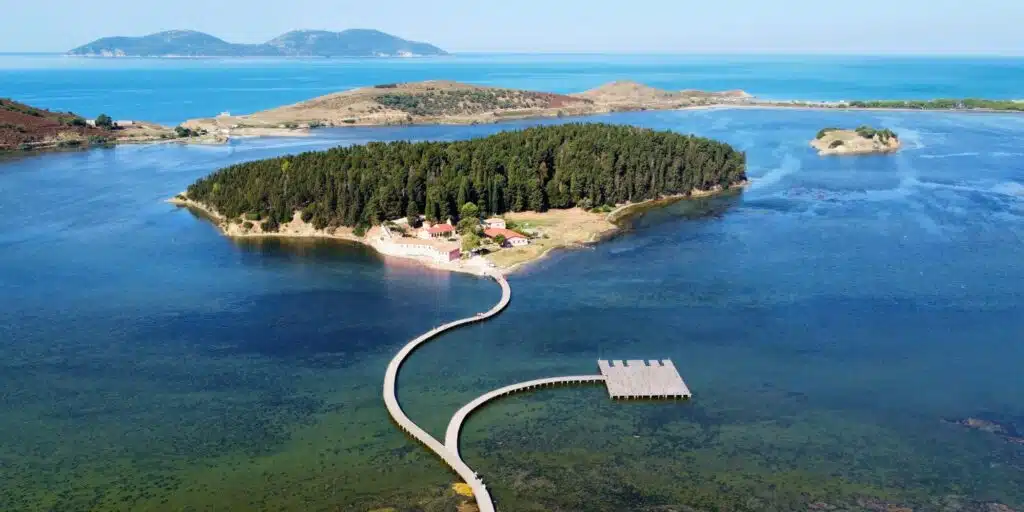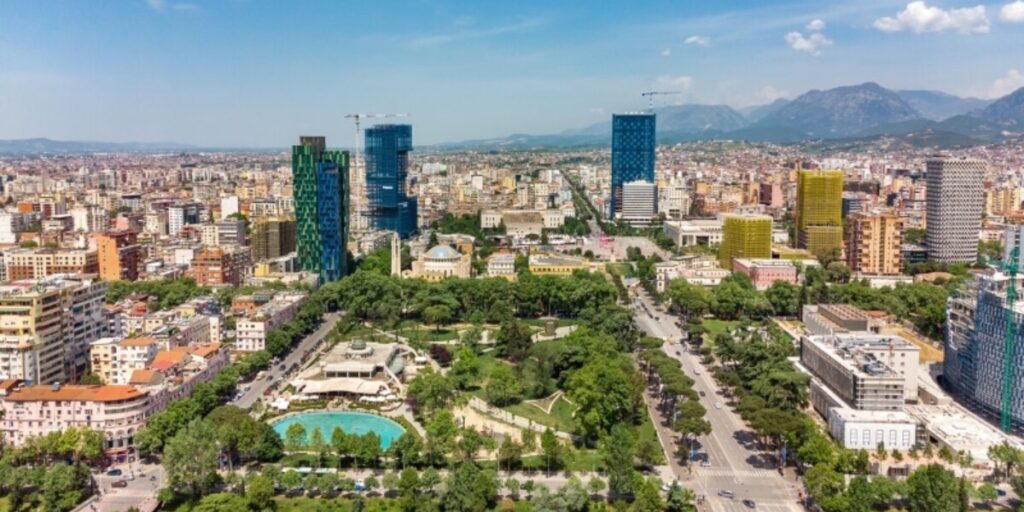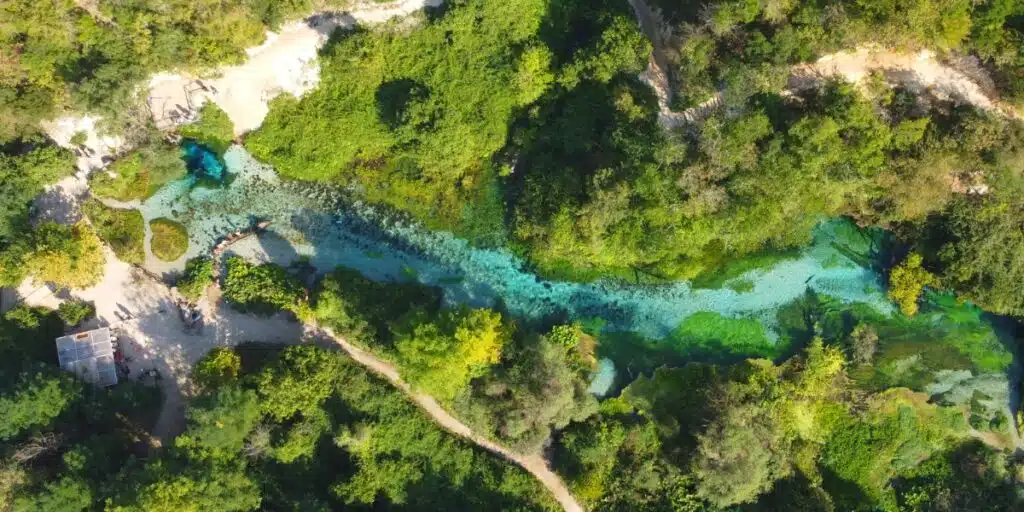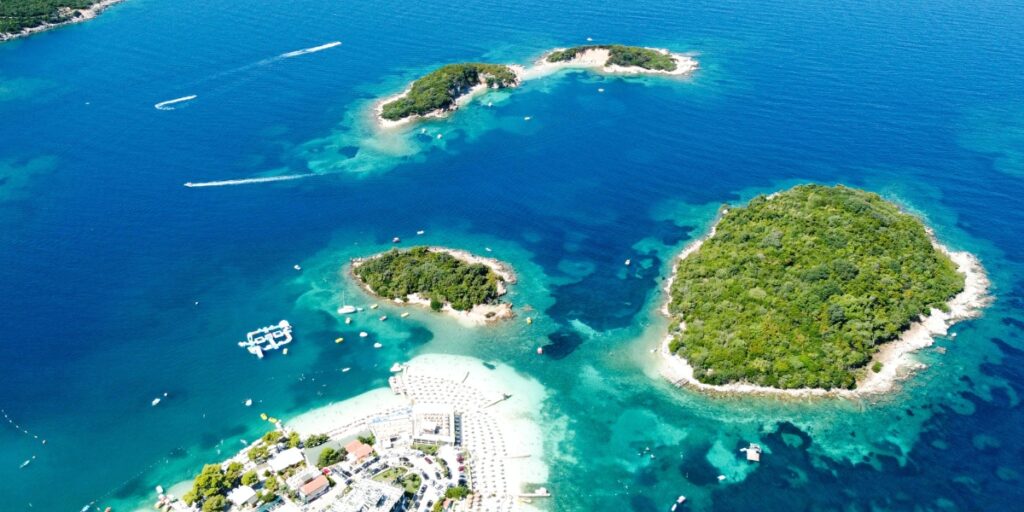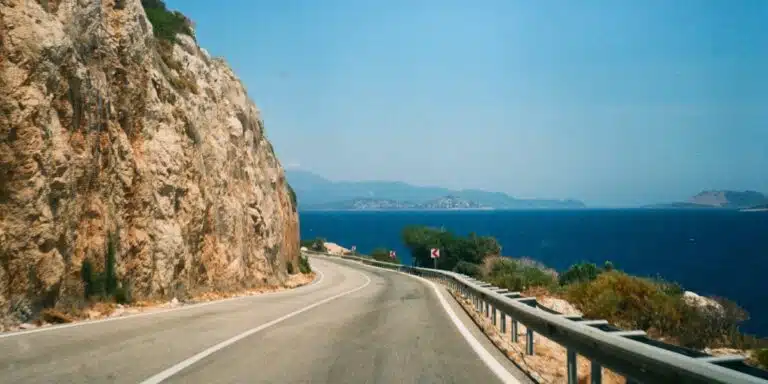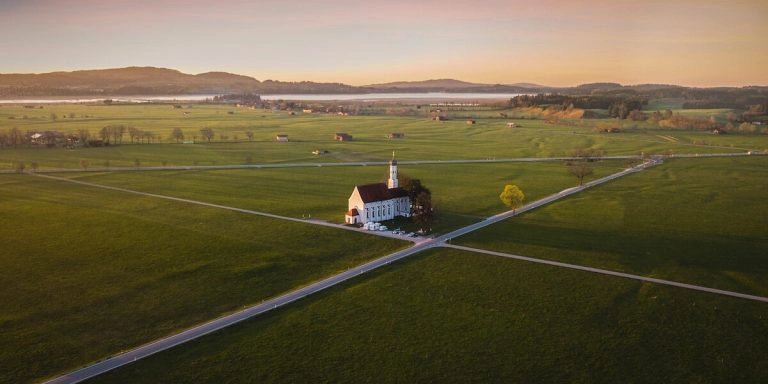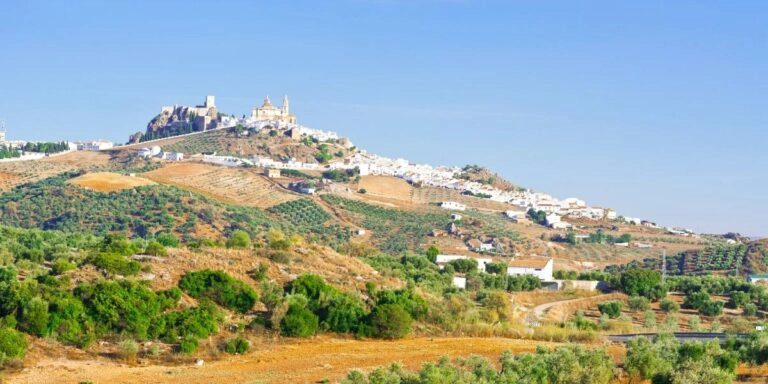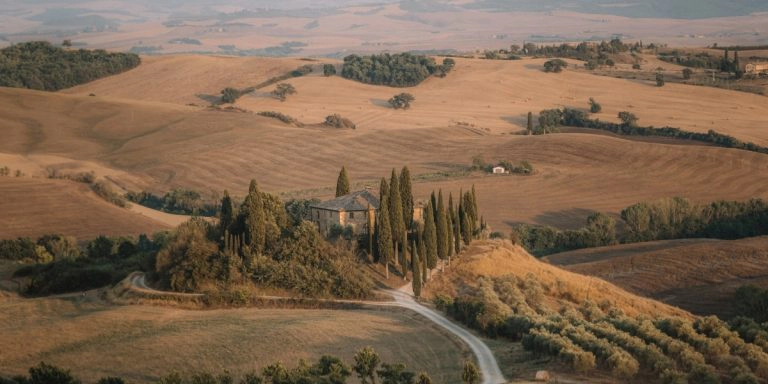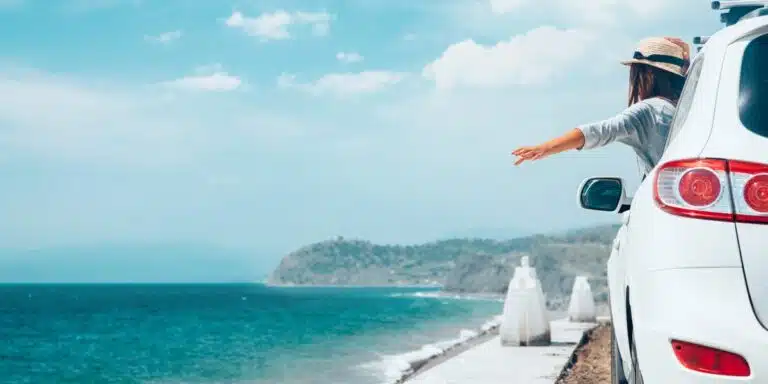This post may contain affiliate links, from which we earn an income. Click here to read our affiliate policy.
With its stunning landscapes and rich cultural heritage, Albania is an increasingly popular destination for adventurous travelers. A road trip in Albania offers a unique way to explore the country’s breathtaking coastlines, charming villages, and rugged mountains at your own pace.
However, navigating the roads here can be quite different from what you might be used to. Our driving Albania guide has all the information you need for a safe and stress-free trip. Whether you’re a seasoned driver or renting a car for the first time, these driving tips and tricks will help you make the most of your Albanian road trip adventure.
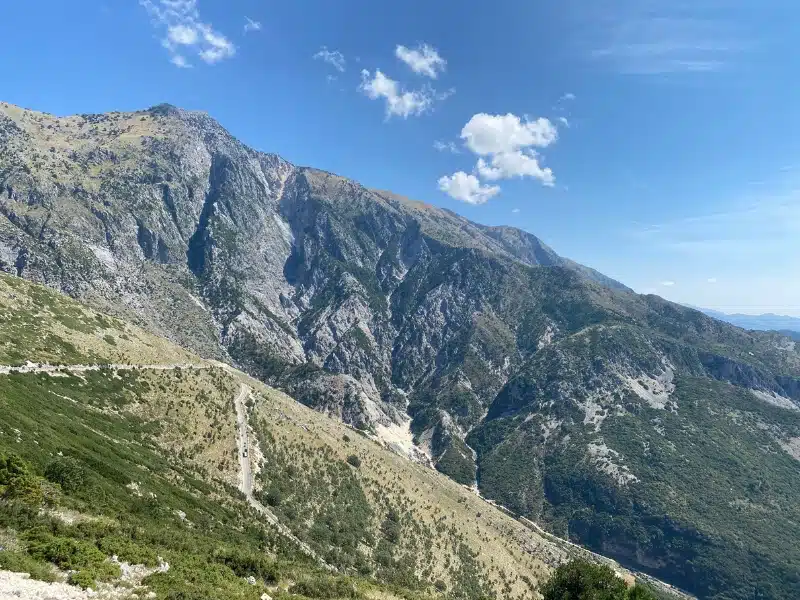
Is it Safe to Drive in Albania?
Lots of readers tell us they are nervous about driving in a foreign country and ask whether driving in Albania as a tourist is safe. According to the World Health Organisation, Albania has 11.7 fatal road traffic accidents per 100,000 inhabitants per year, slightly less than North America’s 12.4, but more than Europe’s 9.3.
We spent four months in our overland truck in Albania and drove to the four corners of the country. However, Albania is a rapidly developing country, and it is not the same as Europe or the USA. The risks, dangers, and rules of the road are different, especially the unwritten ones!
However, driving in Albania can be safe if you stay vigilant, drive carefully, and anticipate the unexpected, especially in cities and on rural off-the-beaten-path roads.
RELATED POST: Is Albania Safe? A Comprehensive Guide for Adventurous Travelers
Make sure you have travel insurance you can trust when visiting Albania. We recommend True Traveller for their 5-star TrustPilot reviews, variety of cover options, best activities cover as standard, great prices, and excellent service.
Why Drive Yourself in Albania?
Albania has a well-developed public transport system which includes furgon (shared) minibuses, shared taxis, and regular buses. You may wonder why you would want to self-drive when all this exists.
To truly immerse yourself in this emerging tourist destination and experience authentic Albania, you need to venture off the beaten path. While visiting the major tourist attractions is a must, exploring Albania by car for a few days will allow you to discover much more of this unspoiled country.
Taking charge of your itinerary and not relying on a driver or other passengers gives you freedom to explore at your own rhythm. Whether you prefer a leisurely morning, an early start at dawn, or simply meandering to discover intriguing sights as you encounter them, driving in Albania offers you a savvy option.
Opting to drive yourself can provide a sense of security and allow you to dictate your own speed. We’ve observed that some taxi and furgon drivers maintain tight schedules and, in our view, often drive excessively fast and take unwarranted risks considering the road conditions.
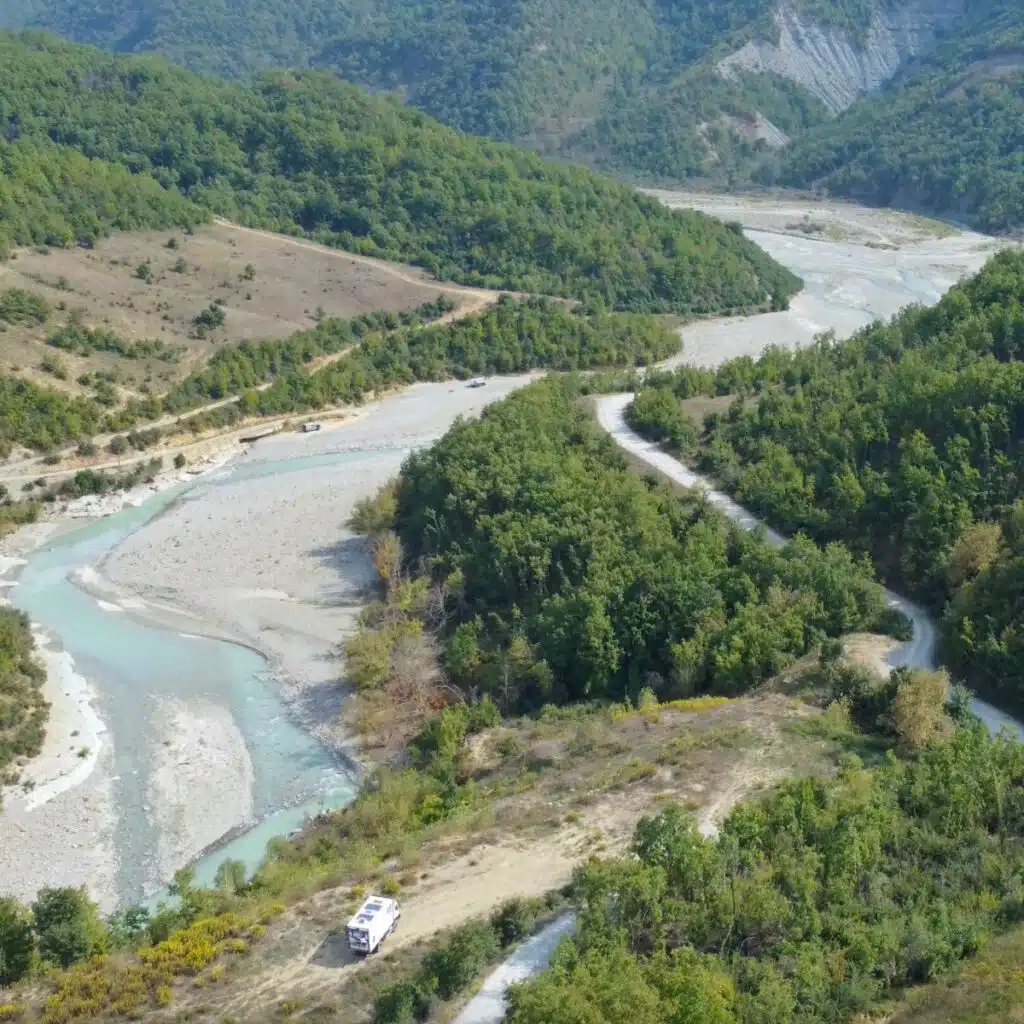
Are you planning a road trip in Albania? Get our Albanian road trip tinerary for info and tips about things to see and do en route + maps and nearby attractions so you don’t miss a thing!
Renting a Car in Albania
Even if you hire a car for your Albanian road trip from a reputable international chain, there may be language barriers and opaque practices when you get to the car rental company depot, especially if you’re away from the big tourist airports and cities. These are some common issues:
At times, it’s necessary to adapt to the local customs – ultimately, it’s up to you to determine your comfort level and how much flexibility you’re willing to allow during your journey. Make sure to document any damage to the car that hasn’t been previously noted by taking dated photos or videos, and promptly share this information with the car hire company.
We highly recommend securing coverage for the excess you’d be responsible for in case of an accident. This car hire excess insurance can typically be included during the booking process, upon car collection, or through a third-party provider like Insurance4CarHire, which often offers a more cost-effective option.
Most car hire companies won’t allow you to drive your rental car outside Albania. If visiting other countries, like neighboring Montenegro, is an essential part of your trip, check with your hire car company first.
We recommend hiring your car with Localrent.com, an aggregator of local car rental companies. They work with small car rental companies that only operate in their location and closely monitor the quality of their service. This means you get the best service for the lowest price.
If we travel to a country where we can book a hire car with Localrent.com we always take advantage of their great prices and solid and reliable service.
Renting a Campervan in Albania
For a real adventure, hire a motorhome or campervan in Albania. We recommend Motorhome Republic, an aggregate booking site that pulls together all the best deals from a number of rental agencies with depots at Tirana Airport. They offer you a wide choice of options alongside an excellent English-speaking expert motorhome Concierge Team.
Hiring a motorhome or campervan is definitely one of the best ways to see the country. Book well in advance though, this is becoming a really popular way to travel in Albania.
Driving the Llogara Pass
Taking Your Own Vehicle to Albania
Driving to Albania from the UK or Europe is pretty straightforward, and it means you can easily explore the amazing countries of the Balkans on the way, or combine your visit with a road trip in Greece.
You’ll need to temporarily import your vehicle, which you can do for up to six months. We’ve read elsewhere that it’s necessary to register your identity with officials by email before driving your vehicle into Albania. But we’ve crossed into Albania on many occasions with a UK-registered vehicle – from Greece, North Macedonia, and Montenegro – and the TIP (temporary import permit) has always been completed by the border guards on the day.
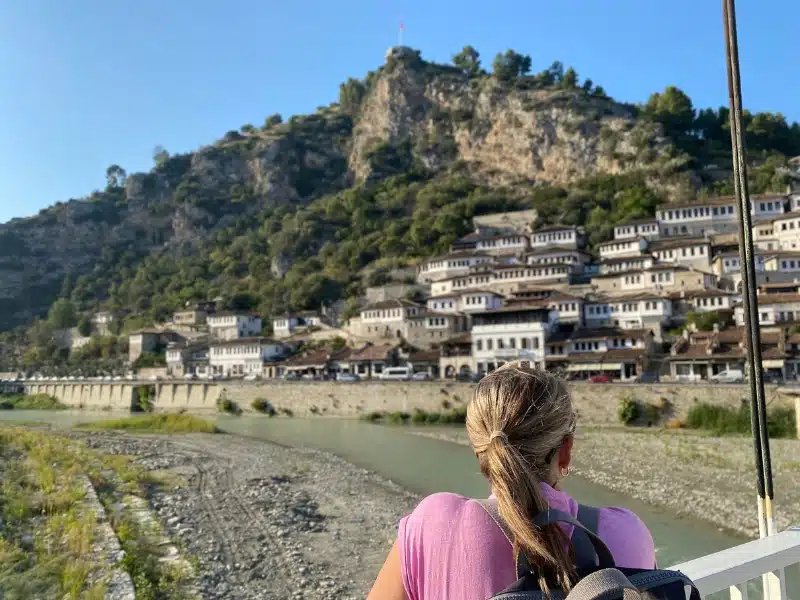
Albania Driving Laws
We have seen every single one of these traffic rules ignored by locals when driving in Albania, but that doesn’t mean as a foreigner you should not follow them.
Looking for the best SIM card deals in Europe for your trip? Check out our guide to the best data SIMs in Europe and get the best deal for your trip to Albania.
Albania Road Etiquette
The Albanian people are kind and friendly, taking pride in their country and the strides they have made since communism collapsed in 1989. However, on the roads, machismo and bullying are the order of the day!
In cities and built-up areas, you will have to take the initiative when coming out of junctions and navigating roundabouts if you want to progress. In rural areas, things are a bit more relaxed, but don’t expect the local farmer with his ancient donkey and cart to pull in so you can get past!
Being bullish when driving may not come naturally, but you may need to adopt this tactic, especially when driving in Albanian towns and cities.
If you’re waiting at traffic lights, the cars behind will start sounding their horns the minute, in fact, the second, the light turns green. If you take a few moments to get into gear and let off the handbrake, the horns will become a cacophony of noise as every other car joins in!
Albanian drivers aren’t necessarily rude but they do lack consideration at times. Parking behavior can be haphazard, with drivers stopping wherever convenient, sometimes disregarding the needs of others and causing delays as other road users maneuver around their vehicles.
There is a fairly common scam in many Balkan countries where local drivers will pull in front of you and then brake sharply causing a collision for which, being the driver behind, you are technically at fault. We know some people this happened to but luckily they had a dash cam mounted on their windscreen and because of this, they were able to fight their case and prove the other party was at fault.

Road Signs in Albania
Road signs in Albania feel familiar and follow the international model, with standard symbols and pictograms. A translation app comes in handy for the Albanian language though!
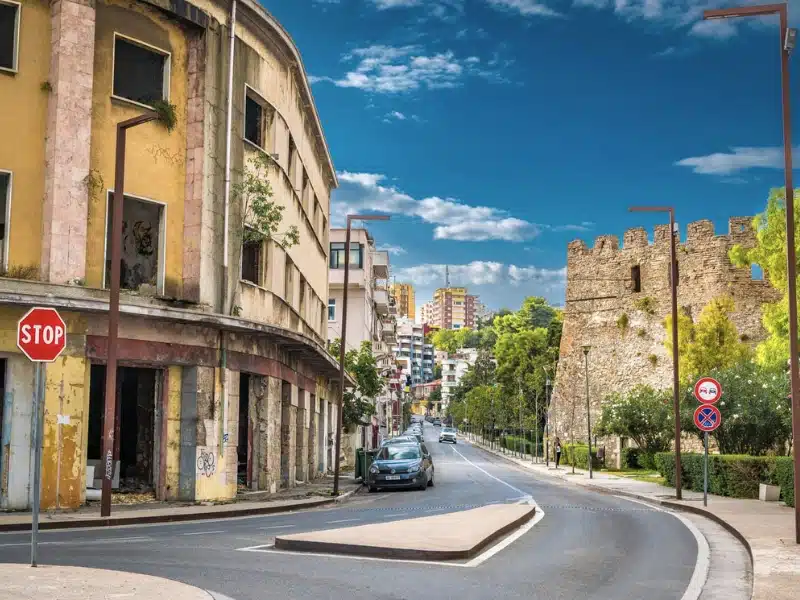
Road Quality in Albania
The standard of roads in Albania varies across the country. While major highways connecting major cities and main roads in and around towns are generally well-maintained and offer smooth travel, rural roads and those in less-developed regions may be rougher and less predictable.
Potholes, uneven surfaces, and occasional lack of signage can pose challenges, especially when venturing off the main routes. However, significant efforts have been made in recent years to improve the road infrastructure, with ongoing projects aimed at enhancing connectivity and safety throughout the country.
The roads heading into and out of Tirana are often incredibly congested and don’t have enough lanes to cope with the volume of traffic. Unless Tirana is on your itinerary, we suggest finding an alternative route. Although Google Maps may say that going via Tirana is the most direct or quickest route, it probably isn’t!
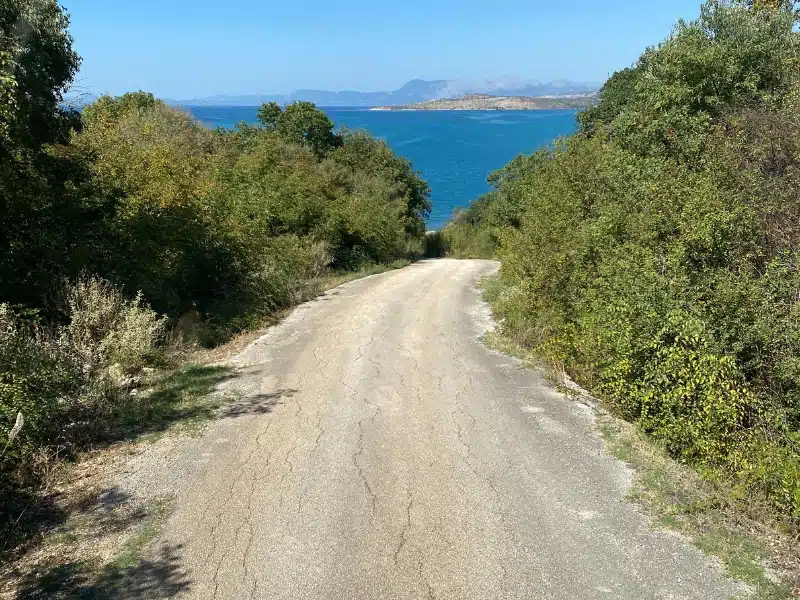
Albanian Weather
Albania experiences a Mediterranean climate along its coastline, characterized by hot, dry summers and mild, wet winters. Inland areas, particularly in the mountainous regions, tend to have a more continental climate, with colder winters and warmer summers. However, weather patterns can vary significantly depending on altitude and geographic location.
During the summer months from June to August, coastal areas can become quite hot, with temperatures often exceeding 30°C (86°F). This heat, combined with the influx of tourists, can lead to increased traffic congestion, particularly in popular resort towns such as Saranda and Durres.
Inland regions may also experience high temperatures, although the mountainous terrain offers some relief with cooler temperatures at higher elevations.
Winter in Albania, lasting from December to February, brings cooler temperatures and increased precipitation, particularly in the form of rain along the coast and snow in the mountains. While snowfall is less common along the coast, it can occur in higher elevations, impacting road conditions and potentially causing delays or closures, especially on rural roads and mountain passes.
Rainfall is distributed unevenly throughout the year, with the wettest months typically occurring between November and February. Heavy rainfall, especially in the mountainous regions, can lead to landslides and flooding, affecting road safety and causing potential hazards for drivers.
Albania’s weather can definitely enhance the driving experience with its diverse landscapes and scenic vistas, but it is also essential for drivers to remain vigilant and adaptable to changing weather conditions, particularly when traveling through mountainous terrain or during periods of inclement weather.
Other Albanian Travel Ideas
Road Works in Albania
Road works are a common sight throughout Albania as the country continues investing in infrastructure development and improvement projects. Major highways, connecting cities and regions, often undergo renovations to enhance safety and efficiency.
These projects can include resurfacing roads, constructing new bridges, widening lanes, and improving signage. While these upgrades are essential for modernizing Albania’s transportation network, they can also result in temporary disruptions and delays for drivers.
Roadworks are generally well managed with systems for two-way traffic to pass and traffic management to control the flow, especially in more built-up areas.
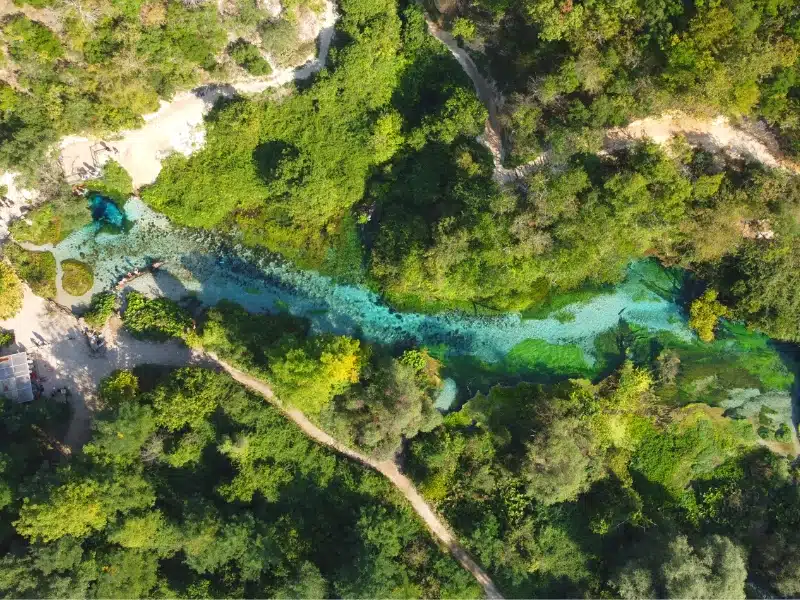
Road Hazards in Albania
When driving in Albania, encountering road hazards is inevitable, and while awareness helps, it can’t always account for the unexpected. Exercising caution in unfamiliar surroundings is paramount.
It’s common for pedestrians and street dogs to stray into the road, particularly in rural areas, often without checking for oncoming traffic. Stay vigilant for furgons, which may abruptly stop on busy roads to pick up passengers from non-designated stops. Try to avoid driving directly behind them.
Exercise caution when overtaking, as some drivers may drive partially on the road and partially on the shoulder to facilitate faster vehicles. Don’t assume it’s safe to overtake without considering others who may be doing the same.
One of the most significant hazards is reckless driving behavior exhibited by other drivers, including excessive speed, failure to signal, overtaking in hazardous locations, and dangerously close maneuvers. Be prepared for sudden braking and erratic driving actions by maintaining a safe following distance and staying alert at all times.
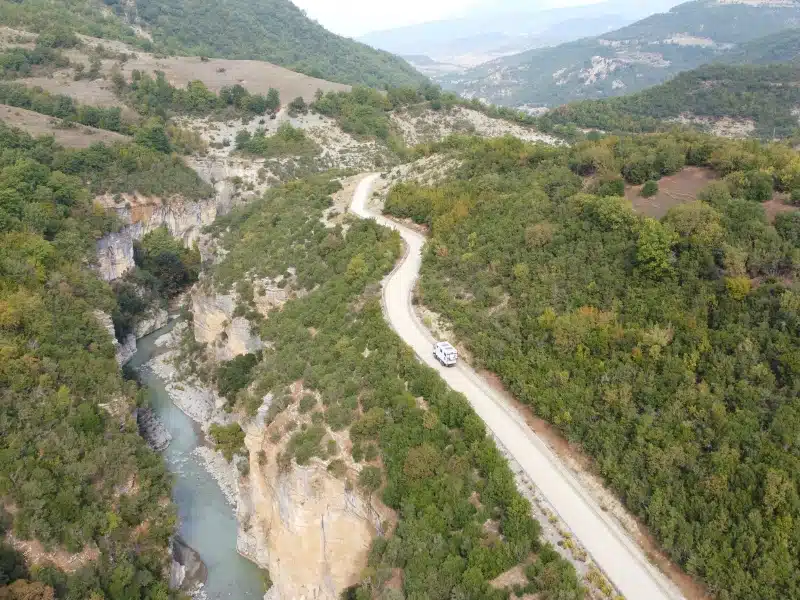
Driving at Night in Albania
Driving in Albania after dark poses significant hazards. It’s advisable to allocate ample time to reach your destination before nightfall, as travel often takes longer than anticipated.
In rural areas, vehicles, including cars and scooters, may not always use their headlights, and roads may lack adequate lighting. If driving after dusk is unavoidable, exercise extreme caution and remain prepared to brake suddenly at all times.
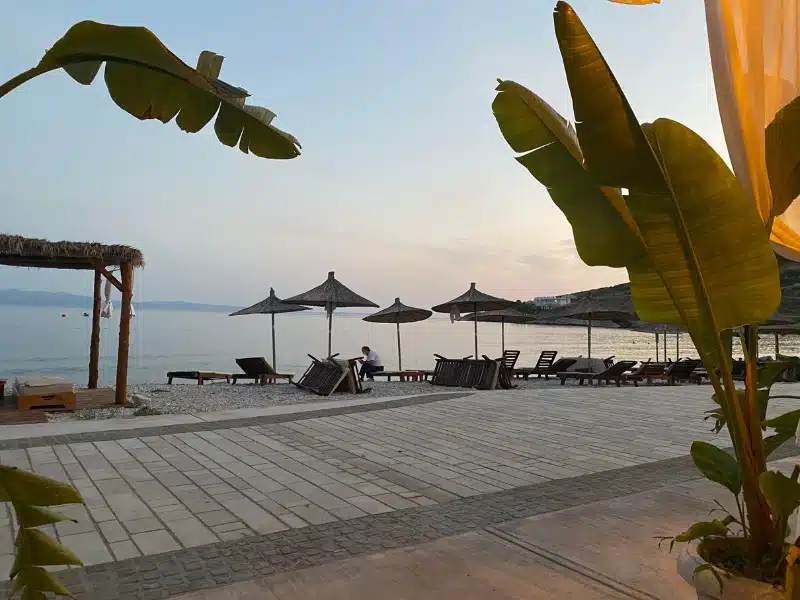
Best Navigation Apps for Albania
There are a number of options to help you navigate in Albania. Maps.me was our go-to sat nav app. Download the app and free Albania map before your trip for offline access and navigation where there is no signal.
Whether you use Maps.me, Google Maps, or any other sat nav or app, the journey time frame is likely to be inaccurate. As a rule of thumb add another third onto the predicted arrival time, and you’ll be about right.
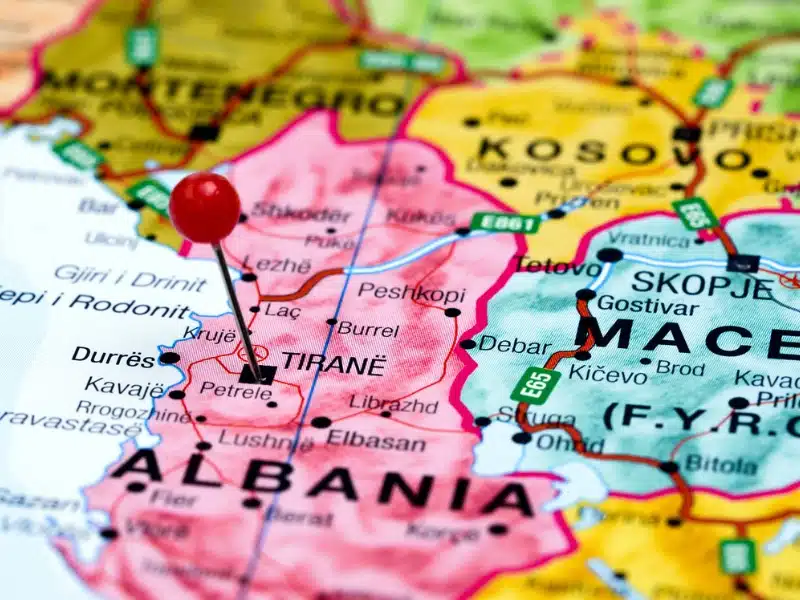
Driving in Albania’s Cities
For some unexplained reason, the quality of driving in Albanian cities tends to decline. If possible, avoid driving in Tirana and Shkodër altogether. Instead, plan to spend time in the city at the beginning or end of your trip and arrange to collect your rental car from the airport or seek accommodation outside the city center.
A good example of the style of driving in Tirana is that when we were transiting through the city, we moved aside to let an ambulance with blue flashing lights get past, only for it to sit in front of us for the next 30 minutes as no other drivers were willing to pull in or make room for the ambulance!
If driving into a city is unavoidable, review your route using a navigation system or mapping app. We found it beneficial to have two different apps running simultaneously; this allowed us to quickly compare routes and determine the most efficient path forward if we encountered any obstacles.
We also recommend making sure all your vehicle doors are locked as you drive through cities and larger towns, and if you leave your car to explore, make sure valuables are not on display. We didn’t encounter any car crime during our time in Albania – carjacking and thefts from cars are relatively rare, but it’s not worth taking the risk.
RELATED POST: Is Tirana Worth Visiting? Top Reasons to Explore the Lively Albanian City
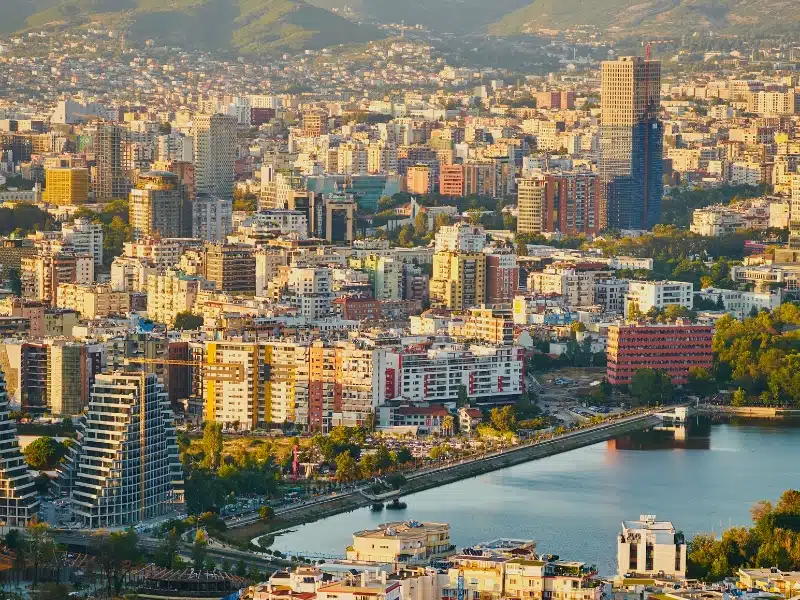
Toll Roads in Albania
There is only one toll road in Albania, the A1 motorway. The road is 114 kilometers long and starts from the port city of Durres and ends at the border with Kosovo.
Toll fees are paid at the toll plaza in LEK or euros (only notes for the latter and change will be given in LEK) or a debit or credit card.
Parking in Albania
Car parking in Albania can be a mixed experience, depending on the location. In larger cities like Tirana and Durres, finding parking spaces can be challenging, especially in busy commercial areas or near popular attractions.
Street parking may be available, but it can be limited and often requires payment at designated parking meters or through mobile apps. Additionally, parking enforcement is active (and quick!) so it’s essential to adhere to local parking regulations to avoid fines or towing.
In some cases, private parking lots or garages offer more secure parking options for a fee. In smaller towns and rural areas, parking is easier and less regulated, with options ranging from roadside parking to designated lots near shopping centers or public buildings.
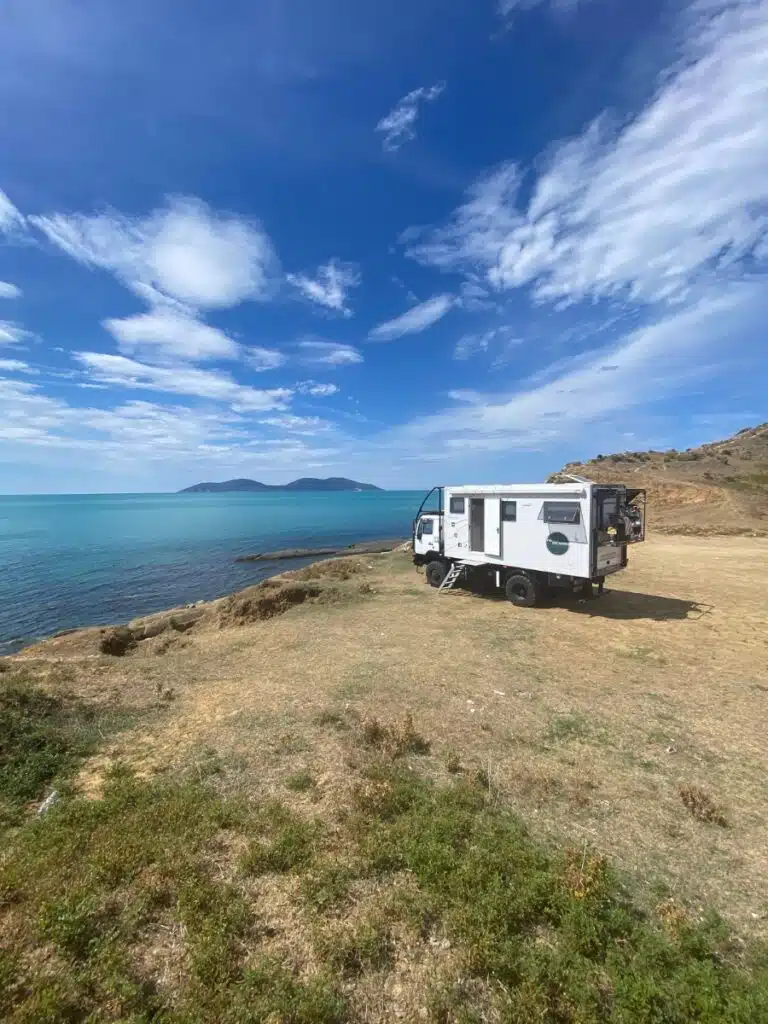
Fuel in Albania
In Albania, diesel is called naftë or motor naftë and unleaded petrol is benzinë pa plumb. Unleaded is usually sold with a choice of two octane grades.
Fuel stations in busy areas feel similar to those in Europe and are self-service, although there are always forecourt staff on hand to assist. Most now require you to pay in advance with a card.
In rural areas, your tank will be filled for you and payment is usually in cash unless you’re happy to pay a 2-3% surcharge to use a card.
Electric vehicles are becoming more common in Albania and there are more EV chargers being installed around the country, mainly along the major highways. You can find a map here.
Breaking Down in Albania
Many UK and European breakdown providers like the RAC, AA, and ADAC, cover Albania under their European cover. Make sure to check first though, as some providers only cover countries in the EU, not in the continent of Europe.
Plan Your Albanian Road Trip Route
Albania is a relatively small country but has many fantastic places to discover. It can take a long time to get to places that look close together on the map, but in reality are hours of driving apart, because of the topography and limited numbers of rural roads.
Map out and plan your road trip route in advance and book your accommodation, particularly where the choices are limited. Leave plenty of time for breaks and stops to take pictures en route, as well as for any unexpected road damage or roadworks.
Plan to arrive in the light where at all possible – it will be easier to find your accommodation and you’ll finish your journey relaxed and stress-free.
RELATED POST: Albanian Road Trip: An Epic & Flexible 7-10 Day Itinerary
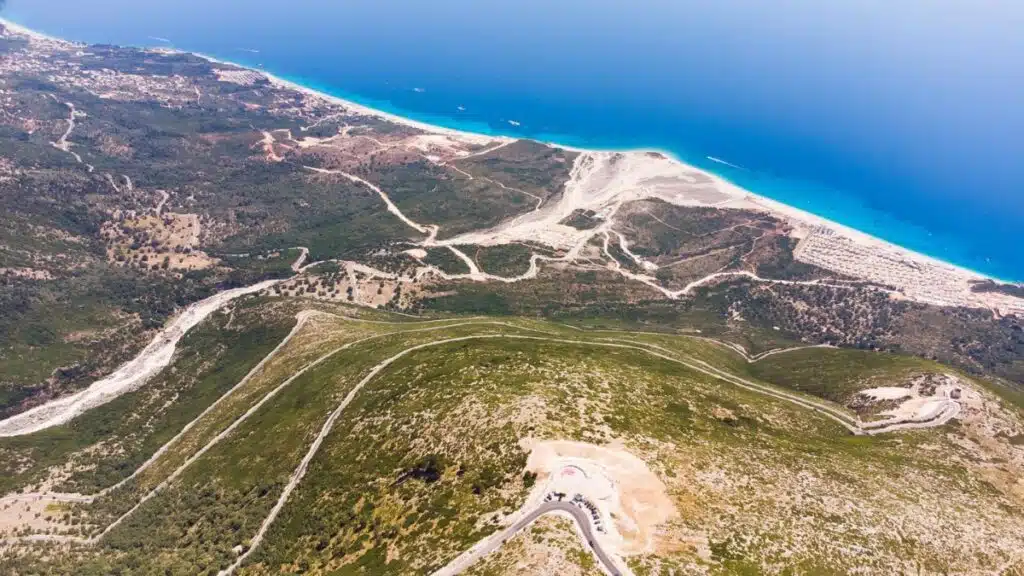
If you’re planning your own road trip in Albania, get practical tips and find out how to work out your route, budget for your trip and book a hire car in our complete guide to planning a road trip.
Be Prepared When Driving in Albania
If you’re still planning a road trip to Albania after reading this, ensure you’re fully prepared before embarking on your journey.
In addition to your essential documents, prioritize packing items like toilet paper (as many restaurants and public restrooms may not provide it), plenty of water, and an abundance of road trip snacks.
Our road trip checklists can help you get organised with packing and pre-trip planning. Easy to download and print, our checklists make sure you stay on top of your planning.
Should I Take a Road Trip in Albania?
Despite the challenges of driving in Albania, we loved the country for its dramatic landscapes, off-the-beaten-path vibe, kind and friendly people, amazing food, and yes, even the roads!
Most of the scenarios mentioned above are extreme cases, and it’s unlikely you’ll encounter a landslide, reckless drivers, or impassable roads during your journey. Throughout our four month stay in Albania, we felt entirely secure and relished the experience of navigating a new driving environment.
Having the flexibility to stop wherever and whenever we pleased, alter our plans spontaneously, and savor the liberty of traveling at our own tempo added richness and adventure to our journey.
Taking the initiative and exploring independently proved far more gratifying than opting for guided tours or bus excursions. Rather than observing from the confines of a bus window, we found ourselves fully immersed in the sights, sounds, and culture of this remarkable country.
Are you looking for more road trip inspiration? Check out these top posts…
European Road Trip: Six Countries in 90 Days
Norway Road Trip: Four Unmissable Routes
Germany Road Trip: 8 Unmissable Routes
The Perfect Andalucia Road Trip: 10-14 Day Itinerary
The Ultimate Bucket List Italy Road Trip
Spring Road Trip from Britain to Portugal
Love it? Pin it!
